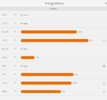I have read through the thread, and there are a number of items which don't seem to add up. We have in the main 4 controls, the lock shield valve, the TRV, the wall thermostat, and the boiler thermostat. In my case boiler does not modulate so wall thermostat is set to on/off, but this is how I understand how the system works.
Boiler and pump fire up at set time and water is circulated around the house.
The lock shield valves control how fast the radiator heats up, so the TRV can control the room temperature without over shooting.
When the water reaches a set temperature the boiler switches off, but pump continues so radiators stay hot, and there is a mark/space ratio which controls how often the boiler fires to maintain the circulating water temperature, between two points.
As the house warms up slowly the circulation in radiators is reduced, so radiator temperature reduces, to just enough to maintain the room at temperature set on the TRV, however even when all TRV's are closed, the boiler will continue to fire up every so often to maintain the water temperature, so we fit a wall thermostat in a lower floor, in a room with no outside doors, or alternative heating, which normally cools fast to turn off the boiler rather than leaving it cycling off/on.
That room rarely exists, so a compromise is to fit both TRV and wall thermostat in the hall, careful matched so whole of house warm before the wall thermostat turns off boiler to stop it cycling.
So far so good, I get that, and setting TRV to 17ºC and wall thermostat to 19ºC because the wall thermostat is higher on the wall, and closer to centre of house, it switches off boiler once whole house warm.
But can't get how the boiler temperature affects heating or efficiency. I don't know why I am given to option to alter it? Clearly the hotter the radiator the faster it heats the room, and the hotter the boiler circulating water is the hotter the DHW is, so a balance between DHW being too hot, and radiators taking too long to heat the rooms. So to keep the DHW cool enough not to burn, I keep boiler temperature down as low as possible.
Cure would be some temperature regulations for the DHW, I suppose a motorised valve in the airing cupboard connected to a tank thermostat? But then really need some method to tell the boiler not required as well, and there is no cabling between airing cupboard and boiler. (C Plan)
Other option is some mixer valve at the taps, and if I can stop the DHW getting too hot, then boiler thermostat could be set a lot higher, which would speed up the rooms reheating. But the radiators are not in a protective box, TABLE 42.1 BS7671 gives the maximum temperatures for items electrical controlled which can be touched, A part (Metallic) which need not be touched for normal operation 80°C and a part intended to be touched but not hand-held 70°C, and hand held 55°C.
So it seems we can go to 80°C, but the water (non metallic) 65°C. Which is just about warm enough to protect from legionnaires, so boiler temperature permitted some where between 65°C and 80°C to comply with BS7671. Only 15°C so why give the user the option to adjust?
OK last house did have a fan assisted Myson radiator, but only one, and that was only radiator in a box so you could not touch it.
So why have the option to adjust boiler water temperature? And what difference will 15°C make?




